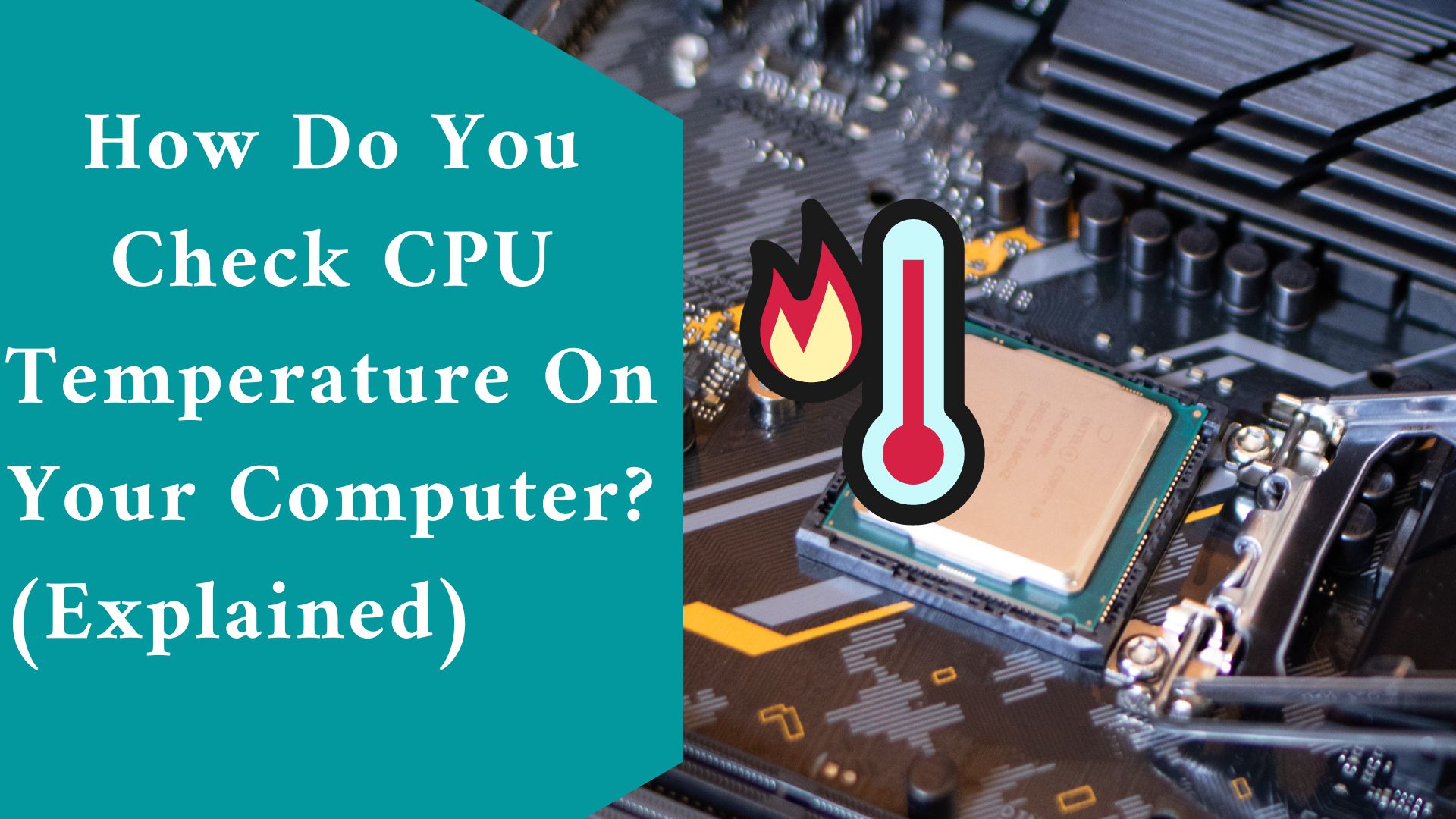High CPU temperatures might be caused by several factors, but one thing is certain: heated CPU temperatures can cause other components and eventually your entire PC to overheat.
Most computer temperatures are within a safe range, but if your CPU reaches its maximum temperature for an extended length of time, problems can occur quickly. Continue reading to learn how to check and monitor CPU temperatures.
How to Check the CPU Temperature of Your Computer
Installing a free CPU heat monitoring tool, such as Core Temp, and watching the CPU temperature for spikes is the simplest way to check your CPU temperature. You can also use Windows’ built-in BIOS/UEFI tool to check your CPU Monitor.
Here’s how to use Core Temp to monitor your CPU temperature:
- Core Temp can be downloaded and installed.
- To access the main dashboard, launch the app.
- Monitor the temperatures for each CPU core under Temperature Readings. The graph below depicts the average CPU temperature for a Quad-Core Skylake laptop, which is around 50°C.
- The maximum processor temperatures measured by Core Temp are displayed in the Max column. In addition, the Load column displays the current CPU load of each core.
While Core Temp is the most simple and easy computer temperature monitor, there is other good CPU monitoring software on the market. Here are a few to consider:
- NZXT’s Cam has a simple UI that lets you monitor computer temperatures and other hardware metrics from a mobile app.
- HWInfo gives you an in-depth look at all technical elements of your hardware, including an overall PC temperature monitor and a CPU heat meter for each specific CPU.
- Open Hardware Monitor is an open-source computer temperature program that lets you monitor computer temperatures, speeds, fans, and other specifications.
- SpeedFan allows you to view hard disc temperatures (both HDD and SSD) and modify fan speeds to prevent your CPU from overheating.
View your PC’s temperature in the BIOS/UEFI settings.
If you’re running Windows 11, Windows 10, or a previous version, the BIOS/UEFI has its temperature checked.
To access it, start your computer and press a specified key at startups, such as F12, ESC, F2, or DEL. When you open BIOS/UEFI, the CPU temperature is displayed on the main screen.
This thermometer capability is included in your motherboard’s core software. Unfortunately, it simply allows you to view the PC’s current temperature.
It does nothing to monitor the temperature as you use Windows over time, especially when your PC or laptop is under intense stress.
Constantly Monitor Your CPU Temperature
When working with demanding applications, such as video editing or rendering software, or when using your computer in direct heat or sunshine, you should monitor the temperature of your CPU. That is when heat exceeds a safe CPU temperature.
Core Temp, thankfully, provides an easy way to monitor your CPU temperature at all times, across many cores.
The information is concealed by default, but you can make the CPU temperature monitor visible. It’s simple to configure as a tiny thermometer in your taskbar.
Here’s how to check and monitor your computer’s temperature at all times.
- After installing Core Temp, click the arrow in the taskbar’s notification box. The four numbers on the screen represent the four core temperatures.
- Drag each number to your taskbar by clicking and dragging it. The CPU temperatures are now pinned to your taskbar, allowing you to keep track of them at all times.
If the four numbers get too congested, just the highest temperature of any of the cores can be displayed. Navigate to the Notification Area by clicking Options > Settings within the Core Temp app. Change the display to the Highest temperature per CPU.
Monitor Your CPU Temperature While Gaming
You can’t see your taskbar when you’re playing a game in full-screen mode. In reality, ALT+TAB is more bother than it’s worth just to check the computer temperature.
Fortunately, gamers utilize RivaTuner, a good CPU temperature monitor for gaming. The RivaTuner CPU temp monitor is included with the MSI Afterburner CPU overclocking software.
Here’s how to keep an eye on your CPU’s temperature while gaming:
- RivaTuner/MSI Afterburner to be downloaded and installed.
- After installation, click the arrow in the taskbar’s notification area and pick MSI Afterburner, or double-click the MSI Afterburner shortcut on your desktop.
- Select the Monitoring tab by clicking the Settings button. Scroll down the list to CPU temperature. Enable Show in On-Screen Display by clicking it.
- Finally, start your game. Your CPU temperatures will be displayed automatically, allowing you to conveniently monitor your PC temperature while gaming.
While playing, you can also keep track of additional stats. Select GPU temps, RAM, or utilization information from the Monitoring tab in MSI Afterburner.
While gaming, these values will appear near the CPU thermometer in the top-left area of your screen.

Why should you monitor the temperature of your CPU?
Your computer’s processing unit (CPU) conducts millions of operations each second, causing the processor to get extremely hot.
If it becomes too hot without your knowledge, you may encounter system instability, crashes, and compute slowdowns, as well as long-term damage.
Here are some scenarios in which you should monitor your CPU temperature:
You’re overheating.
When you push your GPU to its limits via overclocking, its temperature will undoubtedly rise. Monitoring your temperatures as an overclocker or gaming PC builder should be at the top of your priority list.
You’ve got a super-thin ultrabook.
Ultrabooks are extremely thin, leaving limited room for proper cooling. Keep an eye on CPU temperatures if you overwork your computers, such as with gaming or graphics rendering, or if you reside in a hotter climate.
You have an ancient computer or laptop.
Dust can accumulate inside the computer chassis over time, slowing or even blocking the fans. Check for high PC temperatures because high CPU temps indicate that it’s time to wipe out dust bunnies or replace fans.
Cleaning your PC’s physical components is the first step in repairing your overheating PC and can even prevent a Mac from overheating.
You are constantly experiencing system freezes and crashes.
If your computer crashes or shuts down at random, it may not be a hardware or software problem. When a system becomes too hot, it may shut down automatically to prevent long-term physical harm from the heat.
Your computer is slow.
You may already use a PC optimization tool to combat performance hogs. You may have followed methods to speed up and clean up your computer.
If things continue to slow down, the CPU may be forced to throttle itself when it hits critical temperatures.
Final thought
The temperature of a regular CPU varies depending on the CPU used. For a normal effort, a temperature range of 40-65°C (or 104-149°F) is considered safe. When running more taxing apps or games, the usual CPU temperature can reach 70-80°C (158-176°F).
Without running anything too demanding, it’s usual to observe CPU temps around 50°C on a desktop gaming PC with plenty of cooling and a high-end CPU. During a typical workday on an Ultrabook a fairly small place for a strong CPU core temperatures should hover around 75°C.
If your CPU continually overheats, consider more effective cooling measures to avoid lasting computer damage.




